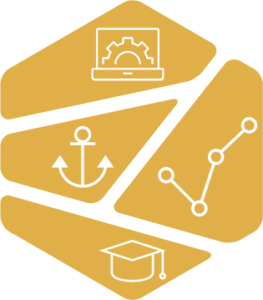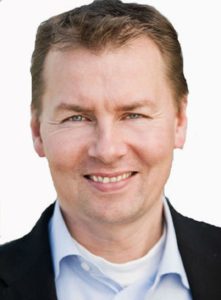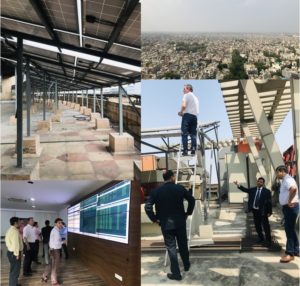Pilot in India – a virtual energy island
By Carsten Gydahl-Jensen, Communication, GECO Global 4. November 2019
 The community of stakeholders in E-LAND has extended to India. In September 2019, the leader of work package two visited BSES, which is one of the four DSOs in the New Delhi area. BSES is covering app. 1.7 mio. consumers electricity needs. BSES will point out some appropriate building blocks to become virtual energy island(s) and try-out the simulation tool developed in E-LAND. BSES will gain knowledge and E-LAND will ensure outreach beyond European borders.
The community of stakeholders in E-LAND has extended to India. In September 2019, the leader of work package two visited BSES, which is one of the four DSOs in the New Delhi area. BSES is covering app. 1.7 mio. consumers electricity needs. BSES will point out some appropriate building blocks to become virtual energy island(s) and try-out the simulation tool developed in E-LAND. BSES will gain knowledge and E-LAND will ensure outreach beyond European borders.

Thomas N. Mikkelsen, Founder and CEO, GECO Global (Photo: GECO Global)
“The collaboration between Europe and India is important in order to solve the issues of implementing and incorporating more renewable energy. As common standing ground, we have both strategies, technologies and know-how in each area and country. When collaborating we would basically be supporting each other to reach a higher goal. Most of all, the demand of energy in India is mostly covered by fossil fuels. There is an extreme need for acting fast to cover the rising energy need and to reach a goal of transforming this into greener energy. Obviously, the sun is shining a lot, so there is a huge potential for PV panels”, says Thomas N. Mikkelsen, Founder and CEO of GECO Global.
A collaboration with huge potential
The idea of having India as part of the E-LAND project is basically to simulate the impact in different conditions in India to get a picture of the obstacles and opportunities there. For example, first it has to be understood which knowledge and know-how from the more advanced European use-cases can be transferred and developed to meet the demands in India. Secondly, a simulation tool will be used to explore the results, when applied across different customer types; offices, governmental buildings and residential building blocks.
“As the situation in India is right now severe, also in sense of pollution, it is really a race against time to have enough energy to support the rising middle class and to be able to get into a new infrastructure which can support the estimated 22 mio people living alone in New Delhi”, Thomas Mikkelsen continues.

PV panels on roof tops in New Delhi (Photo: GECO Global)
A virtual energy island
Data from different building stocks, e.g. office buildings, can be collected and feed into a model run by a computer. By generating a detailed consuming profile, it will be possible to know the demand each minute/hour/day. By simulating using the energy data and weather data like sun hours, it will be possible to get a graphical picture of one particular building. By analyzing the demands of the building, the model can simulate different scenarios, like installing PV panels (solar power generation), installing equipment like a storage device (battery), installing a wind turbine on the roof or other capacities. Secondly, model moderations show how to level out having certain peak demand. And thirdly, by adding the dimension of “energy island”, what will happen, if a network with other buildings in the area is established? Maybe that will enable the building to be supported much better. This is what “a virtual energy island” means.
The Indian stakeholders will gain knowledge on the kind of technology that is available and the strategies should be applied to meet the obstacles that will occur when you try to engage customers. GECO Global, who is leading the work package on engagement activities, met a lot of different opinions and views on how this going to be done. There is definitely a need for a common approach and understanding of the end-users needs so they can also be met. The intension is, that it becomes not only a technical implementation, but a more encompassing simulation, where also the needs of the actual end-users are considered. It is not only becoming a technical implementation race but to take into the account of the needs of the actual end-users. The simulation could eventually lead to an actual pilot in another phase.
A simulation is a “happy case”
“Engaging stakeholders basically means understanding their needs. Normally an implementation is a shortsighted view on how this is going to release a lot of opportunities as we have seen with simulation. It is kind of a typical way of doing this. You do a technical simulation and the shortsighted result is a “happy case”. In reality, theory and practice are not the same, to turn the happy case into reality, you need to understand what can make people sustain the technology. Other than that, it is about getting people onboard having them accepting the technology, making them work together – try out new things”, Thomas adds to the explanation of the interaction of simulation and end-user influence.
“In old days without green energy, it was much easier: Just install new cables and supply the system with more fossil fuel generators. But this can’t be the future scenario. We basically need to deal with the energy production in different ways. Understanding the customer side may provide some flexibility in the demand-response – we need to educate both: The production side and the consumers”, emphasizes Thomas Mikkelsen.
Who is GECO Global?GECO Global is a consultancy in research and analysis, communication, marketing, and community engagement which include behavioral dynamics and stakeholder involvement. In particular, GECO Global are experts in the fields of demand response, energy efficiency, smart building, smart grid and related new business models. Besides being content provider to EU projects, GECO Global advice companies in green transition, product innovation, sustainability governance and human factor. |
||
Social media
E-LAND updates

The E-LAND project aims to develop and demonstrate tools for energy systems to overcome the technical, business, and societal challenges associated with the creation of… (1 year ago)

E-LAND exploitation enhancement activities kickstarted for the final project year Multiple events were executed and many more are planned for the E-LAND project’s final year.… (1 year ago)

A central pillar of the E-LAND project's is risk management. The Norwegian consortium member, Institute for Energy Technology (IFE), implemented a risk management approach to… (2 years ago)

E-LAND H2020 is working with creating a toolbox that is designed to optimize and control multi-energy islands and isolated communities. The toolbox is structured in… (2 years ago)

Smart Innovation Norway together with the University of St. Gallen have developed a series of workshops that began in June 2021 and focused on the… (2 years ago)

About the pilot site: Port of Borg is situated in an industrial area on a small peninsula called Øra just outside Fredrikstad, Norway. Port work… (2 years ago)

Since the mid-1960s, the township of Auroville in Southern India has been striving for sustainable living and the realization of human unity in diversity. In… (2 years ago)